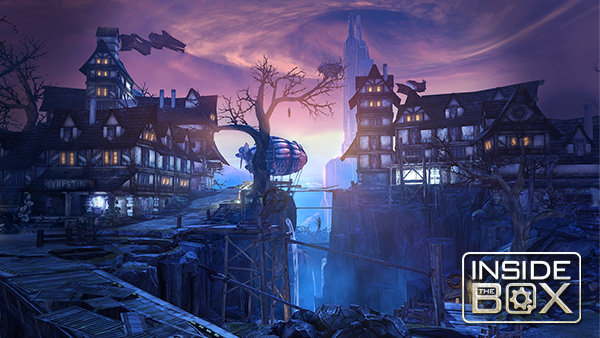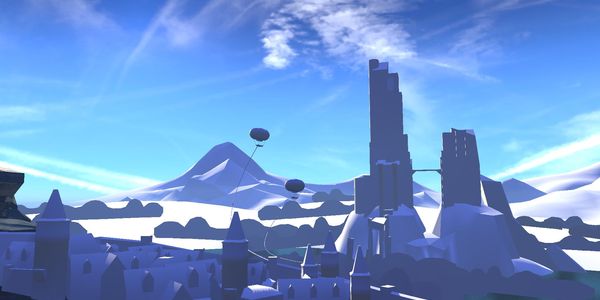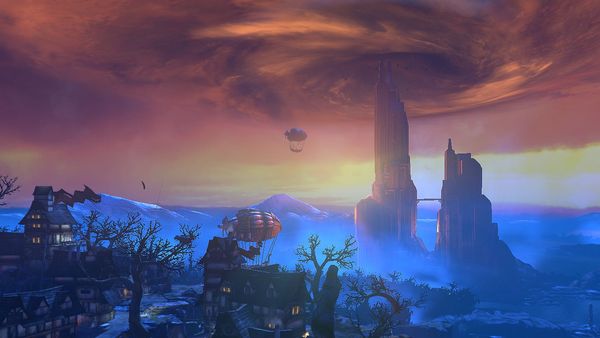
Inside the Box serves as a forum for individuals involved in the production of Gearbox Software content to share personal motives, methods, process and results. Gearbox Software projects are created by a diverse range of individuals spanning a spectrum of different backgrounds, interests, objectives and world views. The views and opinions expressed in this article are those of the author and do not necessarily reflect the official policy or position of Gearbox Software or any of its individual members outside of the author.
Hello! So, my name is Raison Varner and I was one of the audio guys on the recently released Tiny Tina’s Assault on Dragon Keep campaign add-on for Borderlands 2. I’m a sound designer and composer here at Gearbox, and I wanted to take a moment to expand upon some of the other Dragon Keep articles by my fellow teammates (such as Lead Level Designer Ryan Heaton’soverview of our design goals and development process and “Fart Jokes and Tragedy” by Lead Writer Anthony Burch). The fantasy setting in this add-on was something new for the series so I thought I would highlight the development of the music for the main town, Flamerock Refuge.
Jesper Kyd (jesperkyd.com), one of the fantastic composers that we contracted for Borderlands 2, and I (soundcloud.com/rvarner) did the score for this add-on and had a blast doing it!
Writing music for Aster (the internal code name for Tiny Tina’s Assault on Dragon Keep) was a special pleasure for me. I’ve always been a huge fantasy RPG nerd, in fact, Final Fantasy 6 was one of the main reasons I joined the industry, so working on an orchestral fantasy score is one of my favorite opportunities. (Fun little fact… The internal code names we use for projects here are so ubiquitous and ingrained into our heads that I had to actually look up the official title just to make sure I had it right!)
Internally at Gearbox, it wasn’t really well known that I had a primary background in orchestral music. It just was never really relevant because I’ve almost exclusively always been on a Borderlands related project. When I pushed to put some house dance music influenced content in Mad Moxxi’s Underdome for the original Borderlands, it pretty much cemented me as “The Dance Music Guy.”
Funny enough, I had actually had about 10 – 12 years background in full orchestral writing! Dance music production was actually something that I was just starting to learn right before I came to Gearbox. So when I started adding full orchestral music to Aster, many team members were like… “wait, but… you’re the dance music guy!” That was really funny to me because prior to Gearbox it was always “Hey, you’re the orchestral guy!”
So with so many years tied to electronic music influenced scores, working on the Tiny Tina add-on was such an exciting change of style!
With such a large style change, so there was a big challenge on our hands in figuring out how to create a full orchestral fantasy score, yet still retain many of the characteristics that make Borderlands music style unique and familiar within the borderlands universe.
There have been a lot of electronic music influences that inspired me over the years and I tried to draw from them to achieve a unique sound for both Borderlands and Borderlands 2. Artists like Trentemoeller, Massive Attack, Amon Tobin, Deadmau5, Wolfgang Gartner, Air, Royksopp and many others were either provided as reference for our composers or direct influences for much of my own writing for Borderlands 1 and 2.
With influences so vastly different from any orchestral music style, I was asking myself the question of how do you begin to merge those kinds of artists with a fantasy orchestral score? For me, I decided that a good starting point was going to remain inside the general umbrella genre of electronica with artists like Bonobo and Emancipator, whom are some of my absolute favorites because they do such an awesome job of presenting that kind of experimental electronica production with organic palettes of acoustic instruments. I felt that if I tried drawing inspiration from their work with my first experimentation, we might have a cool direction for the fantasy town in Dragon Keep that was analogous to Sanctuary in the main game.
It seemed like that was the right direction to take and that it might produce an interesting sound, but I also thought to myself that perhaps I was needlessly tying myself to the main game and that perhaps I should just focus on fantasy RPG tropes and music styles and just ignore the Borderlands style altogether? As it was, I knew that we couldn’t live in that experimental electronic space musically for the entire add-on and at some point we were going to have to break out to a normal RPG full orchestral score… so why bother trying? Would that just muddle the delivery and cohesiveness of the score?
So I decided that as an exercise, I would try to write two short ideas to explore both angles and see which one felt more appropriate and sticky to me.
I felt that the second concept had a lot more interesting ideas in it with using the mandolin and acoustic guitar samples as a kind of pattern based “groove” which is something that I associate with artists like Bonobo. I thought it married better with the overall general sound of Borderlands even though obviously, you would never find this palette of instrumentation in the main game.
After gathering feedback by sending the clips around to some people on the team who were building the level and involved in the look and feel of the add-on, we opted for the second concept and I started building that out to a full piece.
Part of the challenge in writing early for any game project is the temporary nature of the visuals. Yet, I knew there was no guarantee that I would have time at the tail end of the project to make any modifications or write a new piece, so this was going to be it. I had to try to envision what the level might look like and gather what information I could and hope that was enough to create something that fit with the final product.
As an example, at the time of writing the piece the level looked like this:

Compared to what it eventually came to look like in the final version:

There was also talk of whether it would be sunny or cast in night and shadows and we weren’t sure which was going to be the better decision yet, although it seemed like we were leaning towards the night setting. To complicate matters further, even if we selected a nighttime setting, the player could return to the village in a daytime setting for additional content after the main line quest was completed, so the music had to fit all of those environments.
So moving right along… I ended up fleshing out the second concept piece into a longer version with more structure and instrumentation into this idea:
I really liked the movement in the piece at this point and felt like it was starting to take shape into something that implied that you were about to take a journey. The tone and general feel of the music were setting up well to provide that sense that something was about to happen, “over the horizon.”
I also really liked the groove that was starting to develop and the general feel good nature of the song. I could almost get a sense of grass blowing in the wind and sunshine, etc…
My passion for the idea kind of carried me over into this happy place of a song which was great! That is… it would be if the town were always in sunlight. So now I had to refine the idea down into a better common ground that would play nice with the night time setting too.
In order to help give a bit more air and space to the town music I started trying to add more mood setting space at the beginning and end of the theme for the main town. Although I really liked the idea at the end of Mix 1, it was starting to get into new melodic territory and it just started to feel like it was drudging on and on. Additionally, for that end section to make sense within the piece… I would have had to add another minute of music at least. But the piece didn’t really need it to be a good statement of theme either… so… CHOP!
At this point, the piece had taken its basic shape and just needed some tweaking. There were also a few things that started to really grate on my ears. Some of the plucked instrumentation at the beginning of the piece providing a syncopated groove was way too bright. It kept poking through the music and was really taking away much of the “darker” tones or general “moodiness” of the opening. I also felt like after a loop or two, it was going to become dreadfully repetitive in-game, so I started pairing back and cutting more of those bright plucks out of the piece and added a moderate low pass EQ to the Bazantar pizzicato. I also removed the end section and replaced it with something more ambient so that when the tune looped back around in-game, we had a good separation of time between the heavy groove components in the middle half of the piece and the more subdued “airy” or ambient portions at the beginning and end.
You’ll also notice that I started to focus in on the loudness of the piece as well and the mix got much quieter.
During all of this writing, the Chinese violin and the flute were both intended as placeholder temp instruments. I had planned to get updated libraries (or in a perfect world, real musicians) and replace the Chinese violin with a classical western violin and a Bulgarian flute or recorder / tin whistle.
Only problem was that once I got the solo string libraries, the speed of the legato transitions felt wrong and the entire melodic line started to feel more strident and less soothing and flowing. I thought that maybe it was just that I had grown too accustomed to the Chinese violin and was just having a negative reaction to any change at all… But after leaving them in for a day and coming back and listening to it after 24 hours of not touching the song, I realized that it just wasn’t working. So I put the Chinese violin back in and it just sat so nice and lush inside the mix, I thought it was quite delightful!
As an aside, this is part of the draw back and limitation of having to work solely with sample libraries. There is a happy medium that composers have to reach where we’re trying to write the line we want to hear, but if the virtual instrument we’re using just doesn’t perform it well; you have to find another option or change the line itself. Similar to writing parts that are appropriate to the performer and the instrument’s range you want featured, when relying on a virtual instrument you have to also write to its performance strengths and consider its weaknesses in ways you wouldn’t be concerned about with a live musician.
Luckily, I did not have a similar experience with the Bulgarian flute and I loved how much more musical it sounded than the crappy flute sample I had as a placeholder before. In fact, I fell so in love with the sound of that flute I had added an entire flute melody over the section at 2m 12s and checked it into the game that day. Later that night I listened to it at home and thought… “oh god… that’s awful. How did I ever think that was a good idea!?” And immediately reverted that change the next morning and cut it out of the piece and vowed not to touch that damn flute again, hoping maybe only 25 testers had to suffer a major WTF moment while testing the town. I know that had I left it in there I would have gotten some foot traffic to my room from fellow devs being like “So… ummm… Is that planned to stay in the level like that?”
So after correcting that poor decision, we had a final mix together.
And that was it! It’s hard to remember exactly, but I believe the whole progression was about 3 days’ worth of work, spread over a week or two with some final touches about 6 weeks after I finished Mix 3 to update it with the new libraries I had on hand then.
Because most of my time at work is spent on sound design and less on music, I had to leave my focus on music for about 4 – 6 weeks and devote my concentration to creating sound effects for the Wizards, Golems, Dragons and a bunch of other movers and scripted sequences and cinematics for the add-on.
In wrapping up, I wanted to put in a callout for Jesper Kyd who also wrote some amazing music for this add-on (my personal favorite of Jesper’s work was the music to the Keep Exterior), Josh Davidson, a very talented sound designer and close friend who really killed this project working as the main audio lead (Josh and I worked at a managed, yet very hectic and fast pace), Mark Petty, our director, whose guidance and music critique is always spot on and highly valued plus Andrew Cheney, whom at the time was holding down the fort on other matters while Josh and I got to traipse around making fantasy sound effects and music.
We’ve got such a kickass audio department here; it makes me really proud to be able to be a part of Gearbox.
I hope you enjoyed reading this! Thanks for playing and we all sincerely hope you’ve had a rewarding time and many hours of fun playing Borderlands 2!
If you have any feedback on the articles or what you want to see here on Inside the Box, please let us know at [email protected] or hit up our forums.




